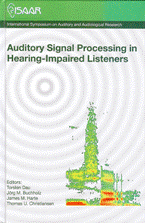Modeling auditory scene analysis by multidimensional statistical filtering may stimulate advances in hearing-aid signal processing
Abstract
‘Auditory Scene Analysis’ (ASA) denotes the ability of the human auditory system to decode information on sound sources from a superposition of sounds in an extremely robust way. ASA is closely related to the 'Cocktail-Party-Effect' (CPE), i.e., the ability of a listener to perceive speech in adverse conditions at low signal-to-noise ratios. This contribution discusses theoretical and empirical evidence suggesting that robustness of source decoding is partly achieved by exploiting redundancies that are present in the source signals. Redundancies reflect the restricted spectro-temporal dynamics of real source signals, e.g., of speech, and limit the number of possible states of a sound source. In order to exploit them, prior knowledge on the characteristics of a sound source needs to be represented in the decoder/classifier (‘expectation-driven processing’). In a proof-of-concept approach, novel multidimensional statistical ltering algorithms such as ‘particle filters’ have been shown to successfully incorporate prior knowledge on the characteristics of speech and to estimate the dynamics of a speech source from a superposition of speech sounds (Nix and Hohmann, 2007).
References
Anemüller, J., and Kollmeier, B. (2000). “Amplitude modulation decorrelation for convolutive blind source separation,” In: P. Pajunen und J. Karhunen (Eds.), Proc. of the second int. workshop on independent component analysis and blind signal separation, Helsinki, pp. 215-220.
Parra, L., Spence, C., and de Vries, B. (1998). “Convolutive blind source separation based on multiple decorrelation,” In: IEEE Neural Networks and Signal Process- ing Workshop, Cambridge, 1998.
Elko, G. W., and Anh-Tho, Nguyen Pong (1995). “A simple adaptive rst-order dif- ferential microphone,” IEEE ASSP Workshop on Applications of Signal Process- ing to Audio and Acoustics, New Paltz, NY, USA.
Greenberg, J. E., and Zurek, P. M. (1992). “Evaluation of an adaptive beamforming method for hearing aids,” J. Acoust. Soc. Am. 91(3):1662-76.
Kompis, M., and Dillier, N. (1994). “Noise reduction for hearing aids: combin- ing directional microphones with an adaptive beamformer,” J. Acoust. Soc. Am. 96(3):1910-13.
Kates, J. M., and Weiss, M. R. (1996), “A comparison of hearing-aid array processing techniques,” J. Acoust. Soc. Am. 99(5):3138-48.
Levitt, H., Bakke, M, Kates, J.M. (1993). “Signal processing for hearing impairment, “Scand. Audiol. Suppl. 38.
Ephraim, Y., and Malah, D. (1985). “Speech enhancement using a minimum mean- square error log-spectral amplitude estimator,” IEEE Trans. Acoust., Speech, Sig. Proc. ASSP 33(2): 443-445.
Bodden, M. (1993). “Modeling human sound-source localization and the cocktail-par- ty-effect,” Acta Acustica 1:43-56.
Marzinzik, M., and Kollmeier, B. (2003). “Predicting the Subjective Quality of Noise Reduction Algorithms for Hearing Aids,” Acta acustica/Acustica, 89, p. 521-529. Nix, J., and Hohmann, V. (2006). “Sound source localization in real sound fields based
on empirical statistics of interaural parameters,” J. Acoust. Soc. Am. 119(1): 463-479.
Hohmann, V., Nix, J., Grimm, G., Wittkop, T. (2002). “Cocktail party processing based on interaural parameters,” Forum Acusticum, Sevilla, SEA, ISBN 84-87985-06-8.
Anemüller, J. (1999). “Correlated modulation: a criterion for blind source separation,” In Joint Meeting "Berlin 99" integrated 25th German Acoustics DAGA Conference, Berlin, p. 4.
Arulampalam, M. S., Maskell, S., Gordon, N., and Clapp, T. (2002). “A tutorial on particle filters for online nonlinear/non-Gaussian bayesian tracking,” IEEE Transac- tions on Signal Processing, 50, 174–188.
Additional Files
Published
How to Cite
Issue
Section
License
Authors who publish with this journal agree to the following terms:
a. Authors retain copyright* and grant the journal right of first publication with the work simultaneously licensed under a Creative Commons Attribution License that allows others to share the work with an acknowledgement of the work's authorship and initial publication in this journal.
b. Authors are able to enter into separate, additional contractual arrangements for the non-exclusive distribution of the journal's published version of the work (e.g., post it to an institutional repository or publish it in a book), with an acknowledgement of its initial publication in this journal.
c. Authors are permitted and encouraged to post their work online (e.g., in institutional repositories or on their website) prior to and during the submission process, as it can lead to productive exchanges, as well as earlier and greater citation of published work (See The Effect of Open Access).
*From the 2017 issue onward. The Danavox Jubilee Foundation owns the copyright of all articles published in the 1969-2015 issues. However, authors are still allowed to share the work with an acknowledgement of the work's authorship and initial publication in this journal.


